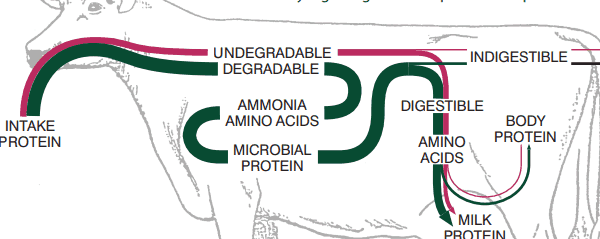
Important Tips on Feeding Protein to Cows
Digestion of Proteins in Ruminants
Ruminants get their protein from a variety of sources, and digestion occurs primarily in two ways. Rumen-degradable proteins are digested in the rumen by microbes and converted to ammonia. The microbes then use the nitrogen present in ammonia to synthesise microbial proteins, which are then consequently digested in the abomasum and intestine to form smaller peptides. Rumen-bypass proteins pass undigested through the rumen directly to the abomasum and intestine, where they are digested with the help of proteolytic enzymes such as pepsin, trypsin and chymotrypsin. Here, they are converted to peptides, along with the microbial proteins from the rumen. Cows need a wide array of proteins for their own metabolism, which includes the formation of haemoglobin, actin, muscle proteins and pepsin. Casein is an important constituent of milk, so high milk-yielding cows require larger amounts of the amino acids that enable casein synthesis. Their higher protein requirement warrants a higher dietary allowance. (Figure from www.dairyweb.ca). In low milk-yielding cows, the dietary requirement for protein is not as high, since cows can synthesise the protein they require from non-protein, non-nitrogen sources. If the protein in their feed is raised beyond their capacity for digestion, it leads to a build-up of ammonia and urea in the body, which could be toxic.

| Essential Amino Acids
Methionine, lysine, phenylalanine, valine, threonine, tryptophan, isoleucine, histidine, arginine and leucine |
Proteins are polymers of 20 amino acids in different combinations. Cows are unable to naturally synthesise 10 of these amino acids, and so they must be present in feed. Methionine and lysine are considered rate-limiting essential amino acids, as these are critical for optimum metabolism and production.
Feeding Protein to Cows
Cows need both rumen-degradable and rumen-bypass proteins; especially rumen-bypass proteins that are high in methionine and lysine. For an animal nutritionist this is a challenge, since accommodating an adequate dose of methionine and lysine may result in an increase in the protein content of feed, and therefore, in its cost. It is prudent to keep the protein level in feed to a bare minimum (14-16%) and supplement this with synthetically-sourced first-limit amino acids.
| Table 2- % of crude protein | ||
| Feed Ingredient | Lys | Met |
| Alfalfa silage | 4.4 | 1.4 |
| Corn silage | 2.5 | 1.5 |
| Grass silage | 3.3 | 1.2 |
| Barley | 3.6 | 1.7 |
| Corn | 2.8 | 2.1 |
| Wheat | 2.8 | 1.6 |
| Brewers grains | 4.1 | 1.7 |
| Canola meal | 5.6 | 1.9 |
| Corn DDG w/sol | 2.2 | 1.8 |
| Corn gluten meal | 1.7 | 2.4 |
| Cottonseed meal | 4.1 | 1.6 |
| Soybean meal | 6.3 | 1.4 |
| Sunflower meal | 3.6 | 2.3 |
| Blood meal | 9.0 | 1.2 |
| Fish meal | 7.7 | 2.8 |
When amino acids are made available directly in the feed, they are degraded in the rumen and therefore must be fed in rumen-protected form. Protected methionine and lysine is available in the market as a supplement Kemin Industries South Asia Pvt Ltd.
Please be aware that feeding excessive amounts of protein to cows is not good for their health, as the protein will be broken down to ammonia, and then converted to urea in the liver, which can have hazardous effects and could compromise fertility. Overfeeding protected methionine and lysine will have the same effect. The excretion of excess urea from the body is also energy-expensive. Feeding lower levels of protein not only reduces the cost of the ration, but also decreases nitrogen excretion and improves herd performance. Table 2 is a summary of the methionine and lysine content of commonly-used feed ingredients. It can be seen that proteins that originate from animal products are rich in these two amino acids. But after the BSE scare in many countries, protein supplements sourced from animal products are prohibited. The only option now is to supplement protected lysine and methionine in the feed.
Protein feeding recommendations
In low-yielding cows, feed containing 14% protein is enough provided that the ration contains the overall required energy value. In high-yielding cows 14-16% protein feed with added protected methionine and lysine is sufficient. While accounting for the methionine and lysine content, naturally occurring amino acids in the feed must also be considered. Regarding the optimal ratio between rumen-degradable and rumen-bypass components, recent trials suggest that a ratio of 51% degradable to 49 % non-degradable is ideal. In some trials 67:33 ratio was also found to be sufficient. In general, rumen-degradable proteins are less expensive, so while determining the ratio it is important to consider the cost.
